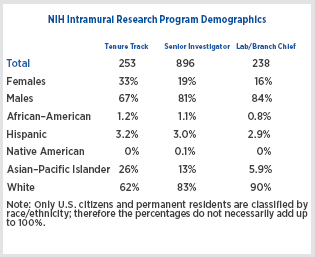From the Deputy Director for Intramural Research
Valuing Diversity at NIH

NIH may seem like a highly diverse scientific community. After all, our intramural program is made up of male and female scientists who represent almost all races from around the world. But among our principal investigators and senior leaders, many groups are significantly under-represented. This problem is particularly apparent among African-American, Native American, and Hispanic investigators and in the relative under-representation of Asian–Pacific Islander scientists in senior leadership positions (see table below). The recent publication in Science of data showing that African–American scientists fare less well than other populations in the NIH extramural peer review process reinforces the urgency of developing strategies for improving diversity of the intramural scientific staff as well. (Science 19:1015–1019 and 940–941, 2011)
We must, then, consider two critical questions for the intramural program: 1) Why are minorities so under-represented among our principal investigators and senior leaders? and 2) What can the intramural research program do to improve research and leadership opportunities for U.S. minority scientists?
The reasons for our lack of diversity are complex and rooted in history. At many levels, few people in the past recognized that a diverse scientific community has an enormous intrinsic value for a scientific program that prizes individual initiative, creative thinking, and team science. Limited diversity was the rule here, so NIH earned a reputation for being inhospitable to minority scientists. Many were reluctant to apply for positions. Furthermore—and this is an area of such sensitivity that we frequently shy away from discussing it publicly—we need to do much more to create an atmosphere of inclusiveness so minority scientists feel more welcome at NIH.

NIH has spent years developing diversity programs aimed at women and minorities, but those efforts have been largely unsuccessful in achieving fair representation for these groups. It’s no wonder that NIH is still perceived as a place that is not uniformly accepting of diversity.
To address this issue with the urgency it demands, I established a Diversity Strike Force, co-chaired by Roland Owens, an assistant director in the OIR, and me. We have been conducting an analysis to understand why NIH has failed to recruit, retain, and promote women and minority investigators. Also, we have:
- added a module on diversity and inclusion of under-represented groups in biomedical research to a leadership course for new tenure-track investigators;
- modified criteria for tenure to better reflect the value we place on making sure that qualified persons from all groups are encouraged to apply for our training and PI positions;
- developed new recruiting materials to attract a diverse group of qualified applicants to our training and PI positions;
- increased advertisement of our intramural tenure-track investigator recruitments at diversity-focused science Web sites such as http://www.minoritypostdoc.org;
- developed a new training module for search committee chairs and modified the memo to PI search committees to encourage thinking broadly about who can contribute to the NIH mission.
The NIH Director has established a Diversity Task Force, which will make additional recommendations, but it is up to everyone at NIH to make sure we have the most hospitable, inclusive environment for all of our scientific staff and that we encourage our non-NIH colleagues to consider careers here. Expect more commentaries and articles on this important topic in future issues of The NIH Catalyst.
This page was last updated on Monday, May 2, 2022
